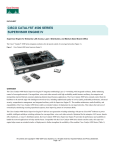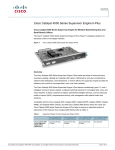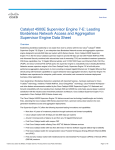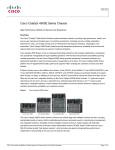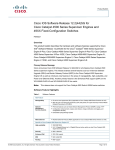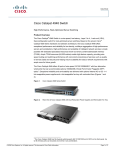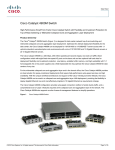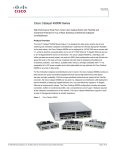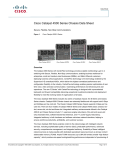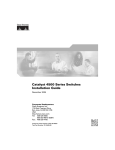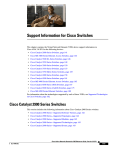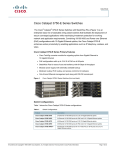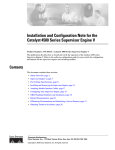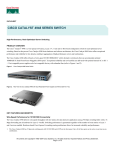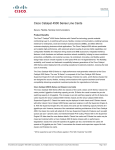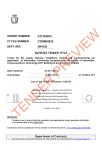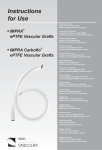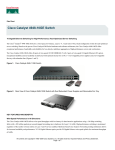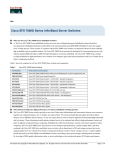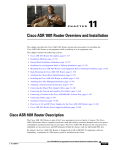Download Cisco Catalyst 4500 E-Series Sup 6-E 2x10GE(X2) w/ Twin Gig
Transcript
Data Sheet Cisco Catalyst 4500 Supervisor Engine 6-E with CenterFlex Technology: Secure, Flexible, Nonstop Communications High-Performance Enterprise Access, Branch, Small and Medium-Sized Business (SMB) and Carrier Ethernet Supervisor Engine with CenterFlex Technology. Overview ® ® The Cisco Catalyst 4500 Supervisor Engine 6-E with CenterFlex technology is an intelligent, high-performance, next-generation extension to the Cisco Catalyst 4500 Series optimized for customers deploying business-critical applications (Figure 1). CenterFlex technology is enabled by Cisco developed application-specific integrated circuits (ASICs) specific to the Supervisor Engine 6-E that deliver industry-leading centralized performance and configuration flexibility. CenterFlex technology helps enable granular optimization of real-time voice, video, and data communications to ensure workforce productivity and profitability and customer success for organizations of all sizes. Figure 1. Cisco Catalyst 4500 Supervisor Engine 6-E Cisco Catalyst 4500 Supervisor Engine 6-E With Centerflex Technology Feature Highlights Centralized ● Centralized 320-Gbps switching capacity with 250Mpps of throughput ● IPv6 support in hardware, providing wire-rate forwarding for IPv6 networks ● Dual 10 Gigabit Ethernet uplinks (X2 optics) ● Hardware forwarding entries: 256,000 ● Quality of service (QoS) services hardware entries: 64,000 ● Security services entries: 64,000 ● Low latency All contents are Copyright © 1992–2008 Cisco Systems, Inc. All rights reserved. This document is Cisco Public Information. Page 1 of 20 Data Sheet Flexible ● ● Flexibility to operate at 6 or 24 Gbps per line-card slot Ability to mix and match 6-Gbps classic and 24-Gbps E-Series line cards, with no performance degradation ● Twin gigabit converter modules that enable flexibility for up to 4 Gigabit Ethernet (Small Form-Factor Pluggable [SFP]) uplinks in the X2 optic slots ● Dynamic hardware forwarding table allocations for ease of IPv4-to-IPv6 migration ● Advanced QoS support with up to 8 queues per port, dynamic queue sizing, and hierarchical policing to provide flexibility and control ● Enhanced security with Unicast Reverse Path Forwarding (uRPF) for added protection against network spoofing attacks ● File allocation table (FAT)-based file system for easier network administration The Cisco Catalyst 4500 Supervisor Engine 6-E is compatible with classic Cisco Catalyst 4500 line cards, chassis, and power supplies, providing full investment protection. The Supervisor Engine 6E delivers 24 Gbps per slot of switching capacity when deployed with the E-Series line cards in a Cisco Catalyst 4500 E-Series chassis. You can mix and match classic line cards and E-Series line cards within a Cisco Catalyst 4500 E-Series chassis with no performance degradation. When you deploy the Cisco Catalyst Supervisor Engine 6-E with classic line cards, all of the new features except the 24-Gbps per-slot switching capacity are inherited. The Cisco Catalyst Supervisor Engine 6-E also provides flexibility and an easy migration path to 10 Gigabit Ethernet uplinks with dual-purpose X2 slots that can accommodate wire-speed 10 Gigabit Ethernet optics or Cisco Twin Gigabit Converter modules (Figure 2), enabling Gigabit Ethernet SFP optics. The Cisco Twin Gigabit Converter Module, which ships standard with the Supervisor Engine 6-E (unless you order 10 Gigabit Ethernet optics on the configuration tool), converts a single 10 Gigabit Ethernet X2 interface into two Gigabit Ethernet port slots that can be populated with appropriate SFP optics, providing a total of 4 Gigabit Ethernet uplinks if used in both X2 interface slots. With the flexibility offered by the Cisco Twin Gigabit Converter Module, you can initially use the gigabit uplinks and then, as your business demands change, you can simply remove the Cisco Twin Gigabit Converter Module and insert 10 Gigabit Ethernet X2 optics to provide full line-rate 10 Gigabit Ethernet uplinks without having to upgrade. The ability to support both Gigabit Ethernet uplinks and 10 Gigabit Ethernet uplinks on a single supervisor engine further demonstrates the flexibility and the investment protection of the Cisco Catalyst 4500 Series. All contents are Copyright © 1992–2008 Cisco Systems, Inc. All rights reserved. This document is Cisco Public Information. Page 2 of 20 Data Sheet Figure 2. Cisco Twin Gigabit Coverter Module: Converting 10 Gigabit Ethernet X2 Interface into Two Gigabit Ethernet SFP Interfaces The increased capabilities and investment protection provided by the Supervisor Engine 6-E and CenterFlex technology facilitates not only scalability for today’s network requirements but also future-proofing by providing significant hardware resources for future growth. Predictable Performance and Scalability The Supervisor Engine 6-E provides a fourfold increase in per-slot switching capacity from previous-generation Cisco Catalyst 4500 supervisor engines: from 6 to 24 Gbps per slot. Table 1 highlights the performance and scalability enhancements of the Cisco Catalyst 4500 Supervisor Engine 6-E. Table 1. Cisco Catalyst 4500 Supervisor Engine 6-E Performance and Scalability Features Feature and Description Supervisor Engine 6-E Centralized switching capacity 320 Gbps Per-slot switching capacity 24 Gbps Throughput 250 Mpps for IPv4 125 Mpps for IPv6 IP v4 routing entries 256,000 IP v6 routing entries 128,000 Multicast entries ● 128,000 for IP v4 ● 64,000 for IPv6 ● 16,000 (Layer 2) shared between IPv4 and IPv6 CPU 1.3 GHz CPU queues 64 Synchronous dynamic RAM (SDRAM) 512 MB upgradable to 1 GB NVRAM No through Bootflash (64 MB) Security and QoS hardware entries 128,000 Cisco Network Admission Control (NAC) and Dynamic Host Configuration Protocol (DHCP) Snooping entries 12,000 MAC addresses 55,000 Active VLANs 4096 Spanning Tree Protocol instances 3000 Switched virtual interfaces (SVIs) 4096 Switched Port Analyzer (SPAN) Maximum of 8 sessions: ingress and or egress All contents are Copyright © 1992–2008 Cisco Systems, Inc. All rights reserved. This document is Cisco Public Information. Page 3 of 20 Data Sheet The Supervisor Engine 6-E is also optimized for multimedia applications with its advanced multicast support offered by features such as Protocol Independent Multicast (PIM), Source Specific Multicast (SSM), and Pragmatic General Multicast (PGM), giving your network additional scalability to support multimedia applications. Chassis and Line-Card Support Already-installed Cisco Catalyst 4500 chassis with classic line cards can take advantage of the new features and functions of the Supervisor Engine 6-E on all ports with a simple supervisorengine upgrade. However, to take advantage of the increased switching capacity of 24 Gbps per slot, the Cisco Catalyst 4500 E-Series chassis and E-Series line cards are required. You can mix and match Cisco Catalyst 4500 E-Series line cards and classic line cards in an E-Series chassis with no performance degradation to either line-card type. Table 2 shows the supervisor-engine and line-card slot-assignment options in the Cisco Catalyst 4500 E-Series chassis. Table 2. Cisco Catalyst 4500-E Chassis Slot-Assignment Options Chassis Single Supervisor Engine 6-E Slot Assignments Redundant Supervisor Engine 6-E Slot Assignments E-Series Line-Card Slot Options Classic Line-Card Slot Options Cisco Catalyst 4503-E Slot 1 – Slots 2 and 3 Slots 2 and 3 Cisco Catalyst 4506-E Slot 1 – Slots 2 through 6 Slots 2 through 6 Cisco Catalyst 4507RE Slot 3 or 4 Slots 3 or 4 Slots 1, 2, and 5 to 7 Slots 1, 2, and 5 to 7 Cisco Catalyst 4510RE Slot 4 or 5 Slots 4 or 5 Slots 1 to 3 and 6 and 7 Slots 1 to 3 and 6 to 10 Note: You can mix E-Series and classic line cards within a chassis. The Cisco Catalyst 4510R- E supports only classic line cards in slots 8 to 10 with Supervisor Engine 6-E. Table 3 summarizes the performance capacities of the Supervisor Engine 6-E on a per-chassis basis. Table 3. Cisco Catalyst 4500 Supervisor Engine 6-E Performance Capacity per Chassis Supervisor Engine 6-E (WS-X45-Sup 6-E) Cisco Catalyst 4503-E Chassis Cisco Catalyst 4506-E Chassis Cisco Catalyst 4507R-E Chassis Cisco Catalyst 4510RE Chassis 136 Gbps and 102 Mpps 280 Gbps and 210 Mpps 280 Gbps and 210 Mpps 320 Gbps and 250 Mpps High Availability and Uplinks The Cisco Catalyst 4500 Series was designed for nonstop communications with noninterrupted hardware switching. In addition to redundant power supplies, fans, and clock modules, the Cisco Catalyst 4510R-E and 4507R-E chassis models support 1 + 1 supervisor-engine redundancy, using the Supervisor Engine 6-E. The primary supervisor engine is active and is responsible for normal system operation. The other supervisor engine serves as a secondary standby, monitoring the operation of the primary supervisor engine. Alerts are generated to the network-monitoring software if either of the redundant supervisors fails. Hot-swapping of supervisor engines is supported without disrupting system operation. You can configure software to force switchover of supervisor engines, or you can use the Simple Network Management Protocol (SNMP) to perform switchover. The resiliency features of the Cisco Catalyst 4500 prevent network outages that could result in lost business and revenue. All contents are Copyright © 1992–2008 Cisco Systems, Inc. All rights reserved. This document is Cisco Public Information. Page 4 of 20 Data Sheet Nonstop Forwarding with Stateful Switchover (NSF/SSO) offers continuous packet forwarding during supervisor-engine switchover. Information is fully synchronized between supervisor engines to allow the standby supervisor engine to immediately take over in subsecond time if the primary fails. In Service Software Upgrade (ISSU) allows you to upgrade or downgrade complete Cisco ® IOS Software images with minimal to no disruption to the network when using a redundant Cisco Catalyst 4500 E-Series system with dual supervisor engines. Facilitating rapid, nondisruptive software upgrade for new line cards, new power supplies, new features, or bug fixes, ISSU offers continuous packet forwarding during the supervisor-engine switchover running different Cisco IOS Software releases. NSF/SSO and ISSU dramatically improve the network reliability and availability in a Layer 2 or Layer 3 environment. NSF/SSO and ISSU are essential for business-critical applications such as voice over IP (VoIP). These features help ensure that VoIP calls are not dropped .. NSF/SSO and ISSU will be supported in the Supervisor Engine 6-E in a Q1 CY’08 Cisco IOS Software release. Table 4 shows the high-availability and uplink options for the Supervisor Engine 6-E. Table 4. Supervisor Engine 6-E High-Availability and Uplink Options Feature and Description Supervisor Engine 6-E Redundant capable Yes Cisco Catalyst 4507R or 4507R-E model Cisco Catalyst 4510R or 4510R-E model Active supervisor-engine uplinks in redundant mode Two 10 Gigabit Ethernet (wire-speed) or Four 10 Gigabit Ethernet (2:1 oversubscribed)* or Four Gigabit Ethernet (Cisco Twin Gig Converter Module) or Eight Gigabit Ethernet (Cisco Twin Gig Converter Module)* or One 10 Gigabit Ethernet and Two Gigabit Ethernet each supervisor-engine* Active supervisor-engine uplinks (nonredundant mode) Two 10 Gigabit Ethernet or One 10 Gigabit Ethernet and 2 Gigabit Ethernet (Cisco Twin Gig Converter Module) or Four Gigabit Ethernet (Cisco Twin Gig Converter Module) Uplink optic types SFP (Gigabit Ethernet) with Cisco Twin Gig Converter Module or X2 optics (10 Gigabit Ethernet ports) SSO/NSF and ISSU Yes* * Will be supported in a Q2 CY’08 Release. Please refer to the “Features at a Glance” section of this data sheet for a complete listing of supported features. IP v6 Support IPv6 is important for the future of IP networking and is critical for the expansion of IP address space in the future. IPv6 capability is required by many companies and is being mandated by governments worldwide. This protocol has been supported on the Cisco Catalyst 4500 Supervisor Engine II-Plus to V-10GE engines since Cisco IOS Software Release 12.2(20)EW with software forwarding. The Cisco Catalyst 4500 Supervisor Engine 6-E supports IPv6 Unicast and Multicast in hardware for full line-rate forwarding performance of up to 125 Mpps. The Supervisor Engine 6-E All contents are Copyright © 1992–2008 Cisco Systems, Inc. All rights reserved. This document is Cisco Public Information. Page 5 of 20 Data Sheet also dynamically allocates hardware table space between IPv4 and IPv6 routes to maximize tablespace usage for optimal IPv4-to-IPv6 migration The Supervisor Engine 6-E supports Multicast Listener Discovery (MLD) Snooping for IPv6, enhancing performance and reducing network traffic by allowing a switch to dynamically add and remove hosts from a multicast group. Table 5 highlights the IPv6 capabilities of the Supervisor Engine 6-E. Table 5. Summary of Supervisor Engine 6-E IPv6 Capabilities Feature and Description Supervisor Engine 6-E IPv6 support Unicast and Multicast forwarding done in hardware IPv6 performance 125 Mpps IPv6 routing entries 128,000 Dynamic hardware route table allocations Yes MLD Snooping for IPv6 Yes, in hardware uRPFv6: Strict mode Yes, in hardware Please refer to the “Features at a Glance” section of this data sheet for a complete listing of supported features. For more information about IPv6 feature support and configuration, please refer to the Cisco Catalyst 4500 with Cisco IOS Software Release 12.2(40)SG release notes at: http://www.cisco.com/en/US/products/hw/switches/ps4324/prod_release_notes_list.html and the Cisco IOS Software configuration library at: http://www.cisco.com/en/US/products/sw/iosswrel/ps1839/products_feature_guide09186a00807fcf 4b.html. Intelligent Network Services with QoS and Sophisticated Traffic Management The Cisco Catalyst 4500 Supervisor Engine 6-E provides enhanced QoS features to help ensure that network traffic is classified, prioritized, and scheduled optimally to efficiently deploy a unified communications network that comprises bandwidth-hungry multimedia, time-sensitive (voice), and mission-critical applications. This type of network allows the administrator to differentiate between traffic flows and enforce policies. QoS capabilities include sharing, shaping, and strict-priority configurations for optimal scheduling of egress traffic as well as Dynamic Buffer Limiting (DBL), a flow-based congestion-avoidance feature. The Supervisor Engine 6-E extends the capabilities of previous-generation supervisor engines by providing flexible queuing with up to 8 transmit queues per port with dynamic queue sizing for greater flexibility in classifying and prioritizing traffic. Classification has also been enhanced by providing configurable classification mapping tables applied on a per-port basis, providing greater flexibility in marking traffic. Policing has also been enhanced to include 2-Rate, 3-Color Policing for more granular control and enforcement of traffic policies. Table 6 summarizes the enhanced QoS features of the Supervisor Engine 6-E. Table 6. Summary of Supervisor Engine 6-E Enhanced QoS Features Feature and Description Supervisor Engine 6-E QoS hardware entries 64,000 Policers 16,000 with flexible assignment for input/output Hierarchical policers Yes: 2-Rate, 3-Color Number of Tx queues Flex queues up to 8* All contents are Copyright © 1992–2008 Cisco Systems, Inc. All rights reserved. This document is Cisco Public Information. Page 6 of 20 Data Sheet Maximum Tx queue size Dynamic 56 to 8192 packets per queue, depending on the number and type of line card and the number of queues configured on the port (refer to documentation for more details) Dynamic queue sizes Yes Configurable classification mapping tables Yes Match IP on MAC header Yes Modular QoS compliant Yes DBL: Congestion-avoidance feature Yes QoS sharing Supported on all ports Shaping Yes, per Tx queue Broadcast suppression Supported in Hardware for all ports Multicast suppression Supported in Hardware for all ports * Supported Q1 CY’08 Release Please refer to the “Features at a Glance” section of this data sheet for a complete listing of supported features. Comprehensive Centralized Management The Cisco Catalyst Supervisor Engine 6-E features a single console port and a single IP address to manage all system features. Remote in-band management is available with SNMP, Telnet client, BOOTP, and Trivial File Transfer Protocol (TFTP). Support for local or remote out-of-band management is delivered through a terminal or modem attached to the console interface. USB drive support will be provided in a future software release. The Cisco Smartports macro for Cisco Catalyst switches is also supported, simplifying the configuration of the critical features for Ethernet networks. The Cisco Catalyst 4500 Supervisor Engine 6-E is also FAT file system-capable, allowing images to be copied, saved, etc. with Windows-based machines with a Compact Flash. This capability will be available in a future software release. Table 7. Key Supervisor Engine 6-E Management Features Feature and Description Supervisor Engine 6-E USB drive support Yes, future software release Compact Flash support Yes, 64- and 128-MB options FAT file system support Yes SPAN Up to 8 sessions: ingress and/or egress Please refer to the “Features at a Glance” section of this data sheet for a complete listing of supported features. All contents are Copyright © 1992–2008 Cisco Systems, Inc. All rights reserved. This document is Cisco Public Information. Page 7 of 20 Data Sheet The Cisco Catalyst 4500 Supervisor Engine 6-E also delivers a comprehensive set of management tools to provide the required visibility and control in the network. Managed with CiscoWorks solutions, Cisco Catalyst switches can be configured and managed to deliver end-toend device, VLAN, traffic, and policy management. The CiscoWorks LAN Management Solution (LMS) bundle offers tools such as CiscoWorks Resource Manager Essentials and CiscoView. These Web-based management tools offer several services, including automated inventory collection, software deployment, easy tracking of network changes, views into device availability, and quick isolation of error conditions. Advanced Security The Cisco Catalyst 4500 Supervisor Engine 6-E extends the rich set of industry-leading, integrated security features to proactively lock down a critical network infrastructure by supporting unicast Reverse Path Forwarding (uRPF) in hardware. uRPF helps prevents traffic spoofing by identifying traffic coming in on an unexpected port. The Cisco Catalyst 4500 Supervisor Engine 6-E also reduces network security risks with a rich set of Cisco NAC capabilities and 802.1X-based user authentication, authorization, and accounting (AAA). The security policy enforcement is uncompromised with the wire-rate, dedicated access control lists (ACLs) to fend off everincreasing virus and security attacks. The Cisco Catalyst 4500 Supervisor Engine 6-E offers powerful, easy-to-use tools to effectively prevent untraceable man-in-the-middle attacks, controlplane resource exhaustion, IP spoofing, and flooding attacks, without any change to the end-user or host configurations. Secure remote access, file transfers, and network management are accomplished with the Secure Shell (SSH Versions 1 and 2) Protocol, Secure Copy Protocol (SCP), and SNMPv3, respectively. Table 8. Key Supervisor Engine 6-E Security Features Feature and Description Supervisor Engine 6-E Security hardware entries 64,000 Cisco NAC and DHCP Snooping entries 12,000 uRPF Yes, supported in hardware 802.1X Yes 802.1X extensions Yes* IP Source Guard, Dynamic ARP Inspection (DAI), and DHCP Snooping Yes Cisco NAC Yes * This feature will be supported in a Q1 CY’08 Release. Please refer to the “Features at a Glance” section of this data sheet for a complete listing of supported features. All contents are Copyright © 1992–2008 Cisco Systems, Inc. All rights reserved. This document is Cisco Public Information. Page 8 of 20 Data Sheet Features at a Glance Layer 2 Features ● Layer 2 hardware forwarding at 250 Mpps ● Layer 2 switch ports and VLAN trunks ● IEEE 802. 1Q VLAN Encapsulation ● Dynamic Trunking Protocol (DTP) ● VLAN Trunking Protocol (VTP) and VTP domains ● VTP Pruning ● Port Security on trunk port ● Port Security on Private VLAN ● Port Security on Voice VLAN ● QinQ Passthrough ● Support for 4096 VLANs per switch ● Per-VLAN Spanning Tree Plus (PVST+) and Per-VLAN Rapid Spanning Tree (PVRST) ● Spanning Tree PortFast and PortFast Guard ● Spanning Tree UplinkFast and BackboneFast ● 802.1s ● 802.1w ● 802.3ad ● 802.3af (Power over Ethernet [PoE]) ● Spanning Tree Root Guard ● Cisco Discovery Protocol ● Internet Group Management Protocol (IGMP) Snooping v1, v2, and v3 ● IPv6 MLD Snooping v1 and v2 ● Cisco EtherChannel technology, Cisco Fast EtherChannel technology, and Cisco Gigabit ® EtherChannel technology across line cards ● Port Aggregation Protocol (PAgP) ● Link Aggregation Control Protocol (LACP) ● IGMP Querier ● IGMP Fast Leave ● VMPS client ● Unidirectional Link Detection (UDLD) and aggressive UDLD ● Voice VLAN and VLAN ID (VVID) ● Jumbo Frames (up to 9216 bytes) ● Baby Giants (up to 1600 bytes) ● Traffic Storm Control (formally known as Broadcast/Multicast Suppression) ● Forced 10/100 Autonegotiation ● Bridge Protocol Data Unit (BPDU) Guard ● Link Layer Discovery Protocol (LLDP) All contents are Copyright © 1992–2008 Cisco Systems, Inc. All rights reserved. This document is Cisco Public Information. Page 9 of 20 Data Sheet Layer 3 Features ● Hardware-based IP Cisco Express Forwarding routing at 250 Mpps ● IP routing protocols: Enhanced Interior Gateway Routing Protocol (EIGRP), Open Shortest Path First (OSPF), Routing Information Protocol (RIP), and RIPv2 ● Static Routing ● Inter-VLAN Routing ● Border Gateway Protocol Version 4 (BGPv4) and Multicast Border Gateway Protocol (MBGP): Q1 CY’08 Release ● Virtual Route Forwarding—Lite (VRF-Lite) ● Software-based Generic Routing Encapsulation (GRE) Tunneling ● IGMP Filtering on access and trunk ports ● IP Multicast routing protocols: Protocol Independent Multicast (PIM), SSM, and Distance Vector Multicast Routing Protocol (DVMRP) ● Pragmatic General Multicast Source Discovery Protocol (MSDP) ● Internet Control Message Protocol (ICMP) ● ICMP Router Discovery Protocol ● DHCP Server ● Per-port Multicast Suppression ● IP Service-Level Agreement (SLA): Q1 CY’08 Release IPv6 Support in Hardware ● IPv6 Unicast and Multicast Forwarding (done in hardware) ● IPv6 route entries: 128,000 ● IPv6 addressing architecture ● IPv6: Cisco Discovery Protocol IPv6 address family ● IPv6: Cisco Express Forwarding in hardware ● IPv6: Domain Name System (DNS) resolver for AAAA over an IPv4 and IPv6 transport ● IPv6: DNS resolver for AAAA over an IPv6 transport ● IPv6: Extended ACL ● IPv6: ICMP Rate Limiting ● IPv6: ICMPv6 ● IPv6: ICMPv6 Redirect ● IPv6: IP MIB ● IPv6 over IEEE 802.1Q ● IPv6: IPv6 over IPv4 GRE tunnel (tunnel support in software) ● IPv6: Intra-Site Automatic Tunnel Addressing Protocol (ISATAP) ● IPv6: Loopback ● IPv6: Multicast Forwarding Information Base (MFIB) for IPv6 ● IPv6: MLDv1 and v2 ● IPv6: Maximum Transmission Unit (MTU) Path Discovery for IPv6 ● IPv6: Multicast in IPv6 tunnel All contents are Copyright © 1992–2008 Cisco Systems, Inc. All rights reserved. This document is Cisco Public Information. Page 10 of 20 Data Sheet ● IPv6: OSPFv3 ● IPv6: EIGRP for IPv6 ● IPv6: Ping ● IPv6: Router Alert Option ● IPv6: SSH over an IPv6 Transport ● IPv6: Stateless Autoconfiguration ● IPv6: Static routes within IPv6 ● IPv6: AAA ● IPv6: Telnet ● IPv6: TFTP ● IPv6: Traceroute ● IPv6: Duplicate Address Detection ● IPv6: Standard ACL ● IPv6: Tunnels in software ● IPv6: Hop-by-hop option header: Done in software ● IPv6: RIP next generation for IPv6 ● IPv6: uRPF strict mode ● PIMv6 (Sparse Mode) ● BGP: Q1 CY’08 Release High-Availability Features ● NSF/SSO: Q1 CY’08 Release ● Full-image ISSU: Q1 CY’08 Release ● NSF awareness ● Hot Standby Router Protocol (HSRP) ● SSO-Aware Hot Standby Router Protocol ● Virtual Router Redundancy Protocol (VRRP) ● Gateway Load Balancing Protocol (GLBP) Sophisticated QoS and Traffic Management ● Modular QoS CLI (MQC) ● Per-port, per-VLAN QoS ● Eight queues per port ● Dynamic Tx Queue Sizing: Q1 CY’08 Release ● Strict Priority Queuing ● IP differentiated services code point (DSCP) ● 802.1p: Class of service ● Flexible Classification Marking ● Classification and marking based on full Layer 3 and Layer 4 headers ● Input and output policing based on Layer 3 and Layer 4 headers ● Support for 16,000 policers with flexible assignment for input and output All contents are Copyright © 1992–2008 Cisco Systems, Inc. All rights reserved. This document is Cisco Public Information. Page 11 of 20 Data Sheet ● 2-Rate, 3-Color Policing ● Shaping and sharing output queue management ● DBL: Congestion-avoidance feature ● Auto-QoS command-line interface (CLI) for VoIP deployments ● Table Map Support Predictable Performance ● 320-Gbps switching fabric ● Layer 2 hardware forwarding at 250 Mpps ● Layer 3 hardware-based IP Cisco Express Forwarding routing at 250 Mpps ● Layer 4 TCP/User Datagram Protocol (UDP) hardware-based filtering at 250 Mpps ● No performance penalty with advanced Layer 3 and Layer 4 services enabled ● Software-based learning at a sustained rate of 10,000 hosts per second ● Support for 55,000 unicast MAC addresses ● Support for 16,000 multicast MAC addresses ● Support for 256,000 entries in routing table (shared between unicast and multicast) ● Scalability to 4,096 virtual ports (VLAN port instances) ● Bandwidth aggregation up to 16 Gbps through Cisco Gigabit EtherChannel technology ● Bandwidth aggregation up to 160 Gbps for 10 Gigabit Ethernet through 10 Gigabit Ethernet Cisco EtherChannel technology ● Hardware-based multicast management ● Hardware-based ACLs Comprehensive Management ● Single console port and single IP address to manage all system features ● Software configuration management, including local and remote storage ● Optional Compact Flash memory card to store software images for backup and easy software upgrades ● USB drive support: Future software release ● FAT file system support ● Manageable through CiscoWorks Windows network-management software on a per-port and per-switch basis, providing a common management interface for Cisco routers, switches, and hubs ● SNMP v1, v2, and v3 instrumentation, delivering comprehensive in-band management ● CLI-based management console to provide detailed out-of-band management ● Remote Monitoring (RMON) software agent to support four RMON groups (history, statistics, alarms, and events) for enhanced traffic management, monitoring, and analysis ● Analysis support, including ingress port, egress port, and VLAN SPAN ● Layer 2 Traceroute ● Remote SPAN (RSPAN): Q1 CY’08 Release ● Cisco Smartports macros All contents are Copyright © 1992–2008 Cisco Systems, Inc. All rights reserved. This document is Cisco Public Information. Page 12 of 20 Data Sheet ● SPAN ACL filtering ● DHCP Client Autoconfiguration ● Enhanced SNMP MIB support ● Network Timing Protocol (NTP) Advanced Security ● TACACS+ and RADIUS, which enable centralized control of the switch and restrict unauthorized users from altering the configuration ● Standard and extended ACLs on all ports ● 802. 1x user authentication (with port security) ● 802.1x with VLAN assignment, voice VLAN: Q1 CY ‘08 Release ● Router ACLs (RACLs) on all ports (no performance penalty) ● VLAN ACLs (VACLs) ● Port ACLs (PACLs) ● Private VLANs (PVLANs) on access and trunk ports ● DHCP Snooping and Option 82 insertion ● Port Security ● Sticky Port Security on Voice VLAN ● SSHv1 and v2 ● Unicast Port Flood Blocking ● DAI ● IP Source Guard ● VLAN Management Policy Server (VMPS) client ● Cisco NAC Layer 2 802.1X ● Cisco NAC LAN Port IP ● 802.1X Inaccessible Authentication Bypass ● Voice VLAN Sticky Port Security ● SCP ● uRPF Strict Mode (in hardware) Technical Specifications Management ● CiscoWorks LMS; includes CiscoWorks Resource Manager Essentials ● CiscoView ● SNMP v1, v2, and v3 ● RMON I and II ● RFC 1213-MIB (MIB II) ● UDP-MIB ● TCP-MIB ● CISCO-FLASH-MIB All contents are Copyright © 1992–2008 Cisco Systems, Inc. All rights reserved. This document is Cisco Public Information. Page 13 of 20 Data Sheet ● CISCO-IMAGE-MIB ● RFC 2233 (IF-MIB) ● CISCO-CONFIG-MAN-MIB ● CISCO-MEMORY-POOL ● CISCO-CDP-MIB ● RMON-MIB lite (RFC 1757) ● RMON2-MIB lite (RFC 2021) ● HC-RMON-MIB ● SMON-MIB ● ENTITY-MIB (V1-RFC 2037) (V2- RFC 2737) ● CISCO-PROCESS-MIB ● CISCO-CONFIG-COPY-MIB ● CISCO-ENTITY-EXT-MIB ● CISCO-ENTITY-ASSET-MIB ● CISCO-ENTITY-FRU-CONTROL-MIB ● CISCO-ENTITY-SENSOR-MIB ● CISCO-ENVMON-MIB ● BRIDGE-MIB (RFC 1493) ● CISCO-PAGP-MIB ● CISCO-PRIVATE-VLAN-MIB ● CISCO-STP-EXTENSIONS-MIB ● CISCO-VLAN-MEMBERSHIP-MIB ● CISCO-VLAN-IFTABLE-RELATIONSHIP-MIB ● IGMP-MIB ● PIM-MIB ● OSPF-MIB ● CISCO-ENTITY-VENDORTYPE-OID-MIB ● CISCO-SYSLOG-MIB ● CISCO-BULK-FILE-MIB ● CISCO-CLASS-BASED-QOS-MIB ● CISCO-FTP-CLIENT-MIB ● CISCO-HSRP-MIB ● CISCO-IGMP-FILTER-MIB ● CISCO-IPMROUTE-MIB ● CISCO-PORT-SECURITY-MIB ● CISCO-RMON-CONFIG-MIB ● CISCO-VTP-MIB ● ETHERLIKE-MIB ● EXPRESSION-MIB All contents are Copyright © 1992–2008 Cisco Systems, Inc. All rights reserved. This document is Cisco Public Information. Page 14 of 20 Data Sheet ● CISCO-PORT-STORM-CONTROL-MIB Industry Standards ● Ethernet: IEEE 802.3 and 10BASE-T ● Fast Ethernet: IEEE 802.3u, 100BASE-TX, and 100BASE-FX ● Gigabit Ethernet: IEEE 802.3z and 802.3ab ● 10 Gigabit Ethernet: IEEE 802.3ae ● IEEE 802.3af Power over Ethernet (PoE) ● IEEE 802. 1D Spanning Tree Protocol ● IEEE 802.1w Rapid Reconfiguration of Spanning Tree ● IEEE 802. 1s Multiple VLAN Instances of Spanning Tree ● IEEE 802.3 ad LACP ● IEEE 802. 1p CoS Prioritization ● IEEE 802.1Q VLAN ● IEEE 802. 1X User Authentication ● 1000BASE-X (GBIC) ● 1000BASE-X (SFP) ● 1000BASE-SX ● 1000BASE-LX/LH ● 1000BASE-ZX ● RMON I and II standards Supported Cisco Catalyst 4500 E-Series Line Cards and Modules ● WS-X4648-RJ45V-E: Cisco Catalyst 4500 E-Series, 48-port 802.3af PoE 10/100/1000 (RJ45) ● WS-X4648-RJ45V+E: Catalyst 4500 E-Series 48-Port Premium PoE 10/100/1000 (RJ-45) ● WS-X4606-X2-E: Cisco Catalyst 4500 E-Series, 6-port 10 Gigabit Ethernet (X2) ● CVR-X2-SFP: Twin gigabit converter module Supported Cisco Catalyst 4500 Classic Line Cards and Modules ● WS-X4148-FE-BD-LC: Cisco Catalyst 4500 Fast Ethernet Switching Module, 48-port 100BASE-BX-D SMF (LC) ● WS-X4124-FX-MT: Cisco Catalyst 4000 Fast Ethernet Switching Module, 24-port 100BASE-FX (MT-RJ) ● WS-X4148-FX-MT: Cisco Catalyst 4500 Fast Ethernet Switching Module, 48-port 100BASE-FX multimode fiber (MMF) ● WS-X4124-RJ45: Cisco Catalyst 4500 10/100 Module, 24 ports (RJ-45) ● WS-X4148-RJ: Cisco Catalyst 4500 10/100 Module, 48 ports (RJ-45) ● WS-X4148-RJ21: Cisco Catalyst 4500 10/100 Module, 48-port telco (4 x RJ-21) ● WS-X4248-RJ21V: Cisco Catalyst 4500 PoE 802.3af 10/100, 48 ports (RJ-21) ● WS-X4224-RJ45V: Cisco Catalyst 4500 PoE 803.3af 10/100, 24 ports (RJ-45) ● WS-X4248-RJ45V: Cisco Catalyst 4500 PoE 802.3af 10/100, 48 ports (RJ-45) All contents are Copyright © 1992–2008 Cisco Systems, Inc. All rights reserved. This document is Cisco Public Information. Page 15 of 20 Data Sheet ● WS-X4248-FE-SFP: Cisco Catalyst 4500 Fast Ethernet Switching Module, 48-port 100BASE-X (SFP) ● WS-X4232-GB-RJ: Cisco Catalyst 4500 32-Port 10/100 (RJ-45), 2 Gigabit Ethernet (GBIC) modules ● WS-X4302-GB: Cisco Catalyst 4500 Gigabit Ethernet Module, 2 ports (GBIC) ● WS-X4306-GB: Cisco Catalyst 4500 Gigabit Ethernet Module, 6 ports (GBIC) ● WS-X4506-GB-T: Cisco Catalyst 4500 Gigabit Ethernet Module, 6 ports 10/100/1000 802.3af PoE or 1000BASE-X (SFP) ● WS-X4418-GB: Cisco Catalyst 4500 Gigabit Ethernet Module, server switching 18 ports (GBIC) ● WS-X4448-GB-SFP: Cisco Catalyst 4500 Gigabit Ethernet Module, 48 ports 1000BASE-X (optional SFPs) ● WS-X4424-GB-RJ45: Cisco Catalyst 4500 24-Port 10/100/1000 Module (RJ-45) ● WS-X4448-GB-RJ45: Cisco Catalyst 4500 48-Port 10/100/1000 Module (RJ-45) ● WS-X4548-GB-RJ45: Cisco Catalyst 4500 Enhanced 48-Port 10/100/1000 Module (RJ-45) ● WS-X4524-GB-RJ45V: Cisco Catalyst 4500 PoE 802.3af 10/100/1000, 24 ports (RJ-45) ● WS-X4548-GB-RJ45V: Cisco Catalyst 4500 PoE 802.3af 10/100/1000, 48 ports (RJ-45) Supported Pluggables ● GLC-T: 1000BASE-T SFP ● GLC-SX-MM: Gigabit Ethernet SFP, LC connector, SX transceiver ● GLC-LH-SM: Gigabit Ethernet SFP, LC connector, LX/LH transceiver ● GLC-ZX-SM: 1000BASE-ZX SFP ● Cisco Coarse Wavelength-Division Multiplexing (CWDM) Gigabit Interface Converter (GBIC) solution ● Cisco CWDM SFP solution ● X2-10GE-LR: 10GBASE-LR X2 module ● X2-10GE-CX4: 10GBASE-CX4 X2 module ● X2-10GE-LX4: 10GBASE-LX4 X2 module ● X2-10GE-SR: 10GBASE-SR X2 module ● X2-10GE-ER: 10GBASE-ER X2 module ● X2-10GE-LRM: 10GBASE-LRM X2 module Indicator and Port Specifications ● System status: Green (operational); red (faulty) ● Switch usage load: 1- to 100-percent aggregate switching usage ● Console: RJ-45 female ● Reset (switch recessed protected) ● Uplinks: Link and active ● Image management port: 10/100/1000 BASE-TX (RJ-45 female) data terminal equipment (DTE); green (good); orange (disabled); off (not connected) All contents are Copyright © 1992–2008 Cisco Systems, Inc. All rights reserved. This document is Cisco Public Information. Page 16 of 20 Data Sheet Software Requirements The Cisco Catalyst 4500 Series Supervisor Engine 6-E is supported only in Cisco IOS Software and is not supported in the Cisco Catalyst Operating System Software. The minimum software versions are as follows: ● Supervisor Engine 6-E, Cisco IOS Software Release 12.2(40)SG or later Environmental Conditions ● Operating temperature: 32 to 104ºF (0 to 40ºC) ● Storage temperature: –40 to 167ºF (–40 to 75ºC) ● Relative humidity: 10 to 90 percent, noncondensing ● Operating altitude: –60 to 2000m Regulatory Standards Compliance Table 9. Cisco Catalyst 4500 Supervisor Engine 6-E Regulatory Standards Compliance Specification Standard Regulatory compliance CE marking ● UL 60950CAN/CSA-C22.2 No. 60950 ● EN 60950 Safety ● IEC 60950 ● TS 001 ● AS/NZS 3260 ● FCC Part 15 (CFR 47) Class A ● ICES-003 Class A EMC ● EN55022 Class A ● CISPR22 Class A ● AS/NZS 3548 Class A ● VCCI Class A ● ETS 300 386 ● EN 55022 ● EN 55024 ● EN 61000-6-1 ● EN 50082-1 ● EN 61000-3-2 ● EN 61000-3-3 Industry EMC, safety, and environmental standards ● GR-63-Core Network Equipment Building Standards (NEBS) Level 3 ● GR-1089-Core Level 3 ● ETS 300 019 Storage Class 1.1 ● ETS 300 019 Transportation Class 2.3 (pending) ● ETS 300 019 Stationary Use Class 3.1 ● ETS 300 386 Table 10. Ordering Information Product Number Description WS-X45-Sup6-E Cisco Catalyst 4500 E Series Supervisor Engine 6-E, 2x10GE (X2) or 4x1GE (SFP), Console RJ-45,USB WS-X45-Sup6-E/2 Cisco Catalyst 4500 Redundant Supervisor Engine 6-E, 2x10GE (X2) or 4x1GE (SFP), Console RJ-45,USB S45EIPB-12240SG(=) Cisco IOS Software for Supervisor Engine 6-E (IP Base image) S45EIPBK9-12240SG(=) Cisco IOS Software for Supervisor Engine 6-E (IP Base image with 3DES) S45EES-12240SG(=) Cisco IOS Software for Supervisor Engine 6-E (Enterprise Services image) All contents are Copyright © 1992–2008 Cisco Systems, Inc. All rights reserved. This document is Cisco Public Information. Page 17 of 20 Data Sheet S45EESK9-12240SG(=) Cisco IOS Software for Supervisor Engine 6-E (Enterprise Services image with 3DES) MEM-C4K-FLD64M Cisco Catalyst 4500 Cisco IOS Software-Based Supervisor Engine, Compact Flash memory, 64-MB option MEM-C4K-FLD128M Cisco Catalyst 4500 Cisco IOS Software-Based Supervisor Engine, Compact Flash memory, 128-MB option MEM-X45-512MB-E Cisco Catalyst 4500 512MB to 1 GB SDRAM Upgrade for Supervisor Engine 6-E Licensing EIGRP, OSPF, BGP and VRF-Lite, NSF, Multicast Routing, IGMP, MLD (Q1 CY’08 Release) are included with Enterprise Services Software image. Warranty The warranty for the Supervisor Engine 6-E is 90 days; it includes hardware replacement with a 10-day turnaround from receipt of a return materials authorization (RMA). Cisco Technical Support Services Cisco Technical Support Services help to ensure that your products from Cisco operate efficiently, remain highly available, and benefit from current system software to assist you in effectively managing your network service while controlling operational costs. Cisco Technical Support Services provide significant benefits that go beyond what is offered under ® the Cisco warranty policy. Services available under a Cisco SMARTnet service contract that are not covered under a warranty include the following: ● Latest software updates ● Rapid replacement of hardware in next-day, 4-hour, or 2-hour dispatch options ● Ongoing technical support through the Cisco Technical Assistance Center (TAC) ● Registered access to http://www.cisco.com Table 11. Components of Cisco Technical Support Services Service Feature Overview Benefit or Advantage Software support Software support offers maintenance and minor and major updates for licensed feature sets. Downloading new maintenance releases, patches, or updates of Cisco IOS Software helps to enhance and extend the useful life of Cisco devices. Through major software updates, it is possible to extend the life of equipment and maximize application technology investments by: ● Adding new functions that, in many cases, require no additional hardware investment ● Increasing the performance of current functions ● Enhancing network or application availability, reliability, and stability ® Cisco TAC support With more than 1000 highly trained customer support engineers, 390 CCIE experts, and access to 13,000 R&D engineers, Cisco TAC complements your in-house staff with a high level of knowledge in data, voice, and video communications networking technology. Its sophisticated call-routing system quickly routes calls to the correct technology personnel. The Cisco TAC is available 24 hours a day, 365 days a year. Cisco.com This award-winning Website provides 24-hour access to an extensive collection of online product and technology information, interactive network management and troubleshooting tools, and knowledge-transfer resources that can help customers reduce costs by increasing staff self-sufficiency and productivity. Advance Replacement of hardware Advance Replacement and onsite field engineer options supply fast access to replacement hardware and field resources for installing hardware, minimizing the risk of potential network downtime. All contents are Copyright © 1992–2008 Cisco Systems, Inc. All rights reserved. This document is Cisco Public Information. Page 18 of 20 Data Sheet Table 12. Cisco Technical Support Services: Competitive Differentiators Service Feature Overview Benefit or Advantage Worldwide virtual lab This extensive lab of Cisco equipment and Cisco IOS Software versions provides an invaluable engineering resource and knowledge base for training, product information, and recreation and testing of selected network problems to help decrease time to resolution. Cisco TAC training ● Boot camps Cisco is committed to providing customers the latest in technology support. These TAC training programs assist customers in case avoidance and provide knowledge transfer of Cisco networking expertise. ● Tech calls ● Tech forums Cisco Live A powerful suite of Internet-enabled tools with firewall-friendly features, these secure, encrypted Java applets can turn a simple phone call into an interactive collaboration session, allowing a customer and Cisco TAC support engineer to work together more effectively. Global logistics This feature delivers award-winning, worldwide hardware-replacement support with 650 depots, covering 120 countries, at a $2.3 billion investment in inventory, taking advantage of 10,000 onsite field engineers. Cisco IOS Software Cisco IOS Software employs 100 discrete technologies with more than 2000 features. Each year 400 new features are added. Cisco IOS Software is installed in more than 10 million devices and is running on more than 10,000 networks worldwide. It operates on the world’s largest IPv6 and VoIP networks and in all major service provider networks worldwide. For More Information To learn more about how you can take advantage of Cisco Technical Support Services, talk to your Cisco representative or visit: Cisco Technical Support Services at: http://www.cisco.com/en/US/products/svcs/ps3034/ps2827/serv_category_home.html. For additional information about the Cisco Catalyst 4500, visit: http://www.cisco.com/go/catalyst4500. For additional information about Cisco products, contact: ● United States and Canada: 800 553-NETS (6387) ● Europe: 32 2 778 4242 ● Australia: 612 9935 4107 ● Other: 408 526-7209 ● http://www.cisco.com All contents are Copyright © 1992–2008 Cisco Systems, Inc. All rights reserved. This document is Cisco Public Information. Page 19 of 20 Data Sheet Printed in USA All contents are Copyright © 1992–2008 Cisco Systems, Inc. All rights reserved. This document is Cisco Public Information. C78-433760-01 02/08 Page 20 of 20




















